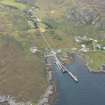Colonsay, Scalasaig, Buaile Riabhach
Burial Cairn (Bronze Age), Standing Stone(S) (Bronze Age)
Site Name Colonsay, Scalasaig, Buaile Riabhach
Classification Burial Cairn (Bronze Age), Standing Stone(S) (Bronze Age)
Canmore ID 37886
Site Number NR39SE 13
NGR NR 38845 94358
Datum OSGB36 - NGR
Permalink http://canmore.org.uk/site/37886
- Council Argyll And Bute
- Parish Colonsay And Oronsay
- Former Region Strathclyde
- Former District Argyll And Bute
- Former County Argyll
NR39SE 13 3884 9436.
(NR 3884 9436) Stone Circle (NR) (Remains of)
OS 6" map (1900)
One stone 7' high and seven smaller stones 1 1/2' to 2 1/2' high, the whole forming part of a small circle, said to represent Christ and the Apostles.
Name Book 1878
The remains of either a small stone circle or a tumulus. In 1881 Sir John McNeil could remember stones being removed from the site and a sword or dagger being found in it, which was at one time in Kiloran House. The appearance of the site appears to confirm its having been opened.
There is no local name for the site. It is sometimes called Buaile Riach (OSM Buaile Riabhach - 'Brindled Field') but this name actually applies to the fields.
S Grieve 1923
This is a kerbed cairn 3.0m in diameter. The stones are as described with the tall orthostat on the E side. The interior has now become earth-filled.
Surveyed at 1/2500.
Visited by OS (BS) 9 April 1974
Field Visit (June 1976)
NR 388 943. On the E side of the old road from Scalasaig Farm to Kiloran and some 200m NE of the farm, there is an unusual kerbed cairn with two standing stones set on the line of the kerb. D-shaped on plan, the cairn measures 3.6m by 3m and 0.3m in height. The larger of the two standing stones (A) is cigar-shaped and measures 2.3m in height and 1.8m in girth at the base; the second stone (B), now leaning outwards at an angle of about 45deg, is 0.65m broad and up to 0.3 m thick and, if erect, would be 1.15m high. Some of the cairn material may have been used to build the nearby wall. The cairn was excavated in 1881, and 'a dagger and a sword, at one time kept at Colonsay House' (Loder 1935, 10), are said to have been found in it but are now lost.
RCAHMS 1984, visited June 1976
Measured Survey (1976)
RCAHMS surveyed the cairn and standing stones with plane-table and alidade at a scale of 1:100. The resultant plan was redrawn in ink and published at the reduced scale of 1:250 (RCAHMS 1984, fig. 52A).




















































